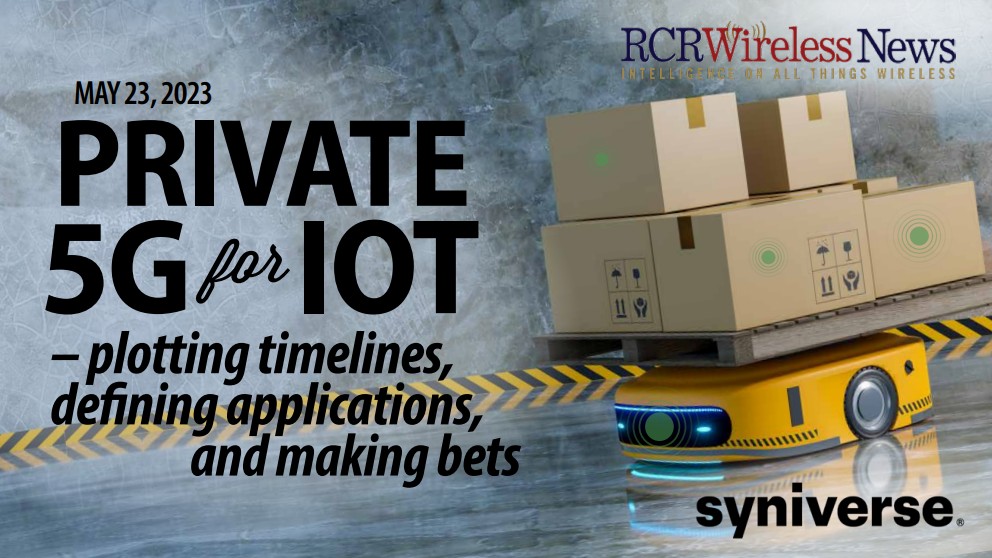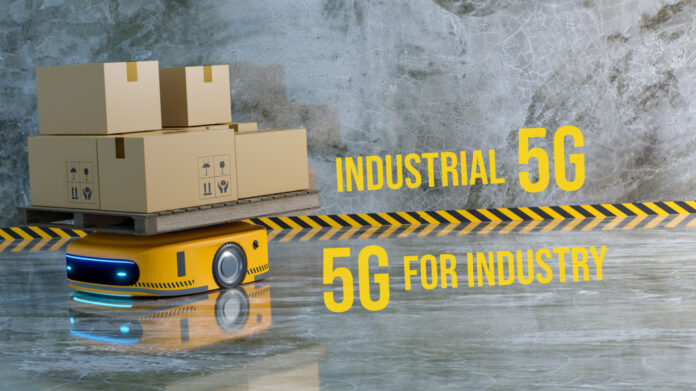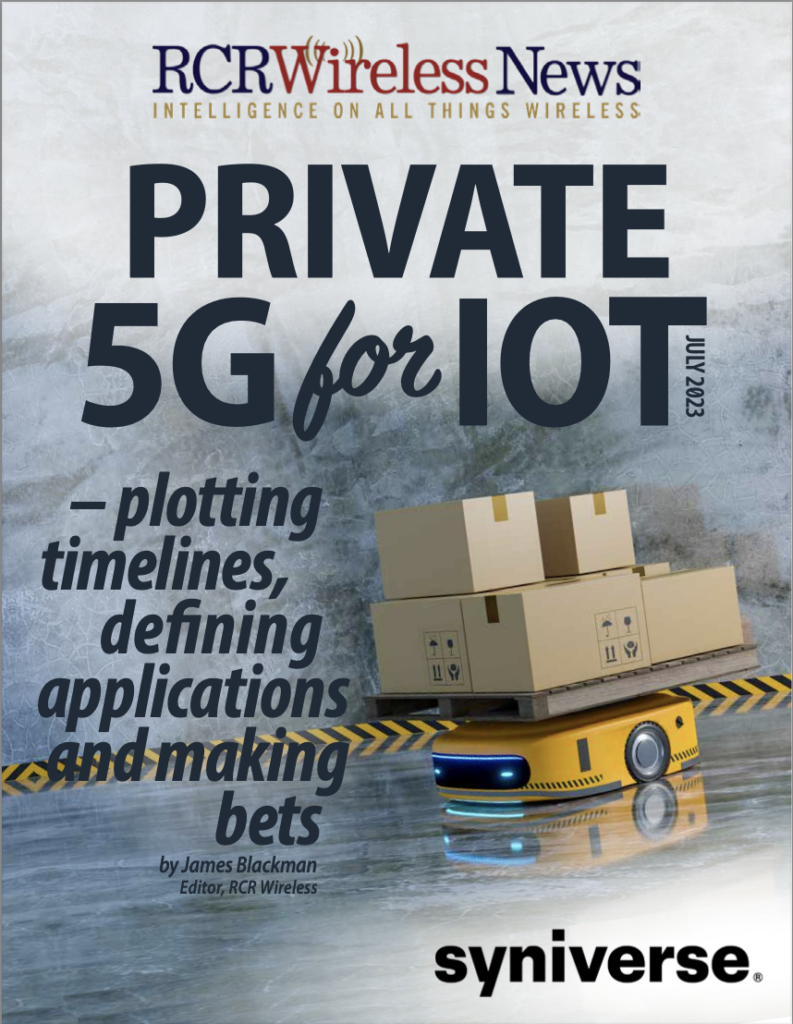Note, this is an excerpt from a new editorial report, called Private 5G for IoT – plotting timelines, defining applications and making bets. The full report is available to download for free here. An on-demand webinar on the same topic is available here.
There is a crucial distinction to make between how IoT sensors are deployed in industrial processes, in the task of making or moving things, for example, and how they are used to bring environmental context to core business processes. This is the difference between ‘industrial IoT’ (IIoT) and ‘IoT for industry’, which might be (usefully/awkwardly?) acronymized as ‘IoT4I’ – as discussed previously, here. These terms (IIoT and IoT4I) are used interchangeably, but they describe fundamentally different applications in the Industry 4.0 space – which, on paper, employ different wireless technologies to deliver them.
For that, one might read high-power industrial LTE and 5G for critical IIoT operations and straighter low-power wide-area (LPWA) IoT standards like LoRaWAN, Sigfox, and utility-focused WiSUN for IoT4I scenarios. The former (IIoT) is about volume, variety, velocity in big data, which (possibly, eventually) only 5G-IoT will deliver; the latter (IoT4I) is for more discrete IoT monitoring in industrial venues, and is well served also by a bunch of shorter-range indoor tech like BLE and Wi-Fi, plus of course cellular-based wide-area (LPWA) systems running on 2G and 4G, as well as 5G-RedCap.
Mobility use cases, mostly for sensor-based IoT asset tracking, but also for orchestrating high-bandwidth mobile robots (AGVs, AMRs, and suchlike), are in fact an adjunct of the latter IoT4I category; they are not integrated process-bound IIoT functions. So too are industrial ODM applications, to provide machine monitoring as-a-service (as offered by machine makers to drive new revenues); so too, in fact, are the kinds of trendy remote AR assistance tools that are currently bringing new value to industrial workforces.
Some of these IoT4I cases are propped up by public cellular infrastructure; many others are bankrolling new private LTE and 5G installations. Take Airbus, most busily rolling out private 5G infrastructure; the revelation for Airbus about private cellular has been to reliably and predictably connect an assortment of handsets, headsets, tablets, and robots. The list of its initial use cases goes like this: connectivity for mobile devices to link to the local manufacturing execution system (MES); augmented and virtual reality (AR and VR) applications for remote assistance and inspections; robots, vehicles (AGVs), and “moving platforms” to transport aircraft parts.
These are all IoT4I applications; in terms of private cellular, they are served by a version of 5G-for-industry (5G4I, if you like), which leans mostly on its broadband (eMBB) and sensor (mMTC) capabilities. At root, they are not IIoT applications, which hinge completely on next-gen 5G – on industrial 5G, as it is delivered more forcefully with its vaunted URLLC capabilities in later 3GPP standards releases, starting in earnest with Release 17 in late 2023 / early 2024.
These Airbus applications, sprung by its private LTE /5G deployments, are in the IoT4I camp, and are decently served either by common LTE technologies, and even better by existing (Release 15 / 16) 5G systems – so long as devices are available. In the end, the reality is this: IoT4I covers a broader set of enterprise applications, many of which are already-familiar in the LPWA networking space, and many of which are gaining traction with new private LTE/5G networks; and IIoT, geared for industrial production and processes, and held up as the ultimate incarnation of Industry 4.0, is a gnarly mess of an ecosystem-play which will take years (2030/31) of tech and teamwork to come off.
Indeed, IIoT is, quite literally, a cluster-f*ck, suggests Bernd Gross, chief technology officer at Germany-based Software AG, in charge of the firm’s IoT and analytics business, which supplies data management tools to a bunch of industrial machine makers. These include the likes of Dürr, DMG MORI, and Zeiss, as well as makers of things like wind turbines (Nordex and Enercon) and medical equipment (Boston Scientific and Eppendorf), plus IoT providers of various stripes, such as AWS, Deutsche Telekom, Microsoft, SAP, Siemens, and others. He knows the trouble with IIoT very well.
“It is much tougher; it requires a lot of manual consultancy and professional services work,” he says. The slight problem with the Software AG analysis is it reverses the IIoT definition; for internal purposes, the German firm groups all these industrial machine makers, selling connected-equipment monitoring as-a-service, under the IIoT banner, even though their machine data is not being made available directly to production lines. “We define IIoT as wind turbines and elevators, and things like that. We don’t think about it as the factory floor, as such, even if some of these machines are being used on the factory floor. Which is how others think of Industry 4.0 (and IIoT),” he explains.
“For that factory-floor case, you have to look across all the machines, to entire production lines, which are multi-vendor. And for that, you need a different skill set… It is impossible for anyone to do all of that alone. Our strategy is to go with system-integrator partners, to use our technology for energy management, performance management, workflow management, and so on. There is a lot of investment in that area, but for us, as a product company, it is a partnership play. Whereas [IoT4I, according to our definition] with equipment makers is our turf, where we are growing fastest.”
The blurred definitions complicate matters; but the meaning is the same. Which of these two IoT disciplines will be bigger, more important, more transformative? This is further addressed in the report; the point, now, is that plain-old IoT cases, of all different kinds – rather than complex IIoT cases – are driving this enterprise 5G tale. (Volkswagen’s hangups, for example, are mostly to reverse-fit 5G into this parallel IIoT narrative.)
What is clear, out of all of this, is that there is a two-speed IoT market developing with private networks, between sensor-based IoT4I applications in (white- and blue-collar) enterprise venues, and complex IIoT systems in collaborative Industry 4.0 systems; the last of these is moving more slowly, but may yet come to define digital change in the 5G era. Dantuluri at Keysight Technologies has a sensible view of it. “If you sub-divide the use cases in Industry 4.0, there are some basic ones,” he says.
“Things like screwdrivers, and other kinds of industrial torque machines, are increasingly being connected to 5G. But those are simple swap-outs of the connectivity module, from WI-Fi to 5G. The other big IoT use cases are to connect AGVs and HMIs (human-machine interfaces; the graphical displays that allow operators to interact with machines and controllers). Those things are being rapidly connected to 5G, wherever private 5G is deployed.”
He goes on: “But these are all quite different to connecting a PLC (programmable logic controller; the industrial computer running a manufacturing process) to a 5G network. Which is a critical application, controlling multi-millions of dollars of production. So yes, if you subdivide Industry 4.0 into less-critical and more-critical use cases, then right now 5G is only being used to connect less-critical use cases. It will take some time for enterprises to trust 5G with these more critical applications.”
To download the full report on private 5G for IoT, from which this excerpt is taken, click here. An on-demand webinar on the same topic is available here.



